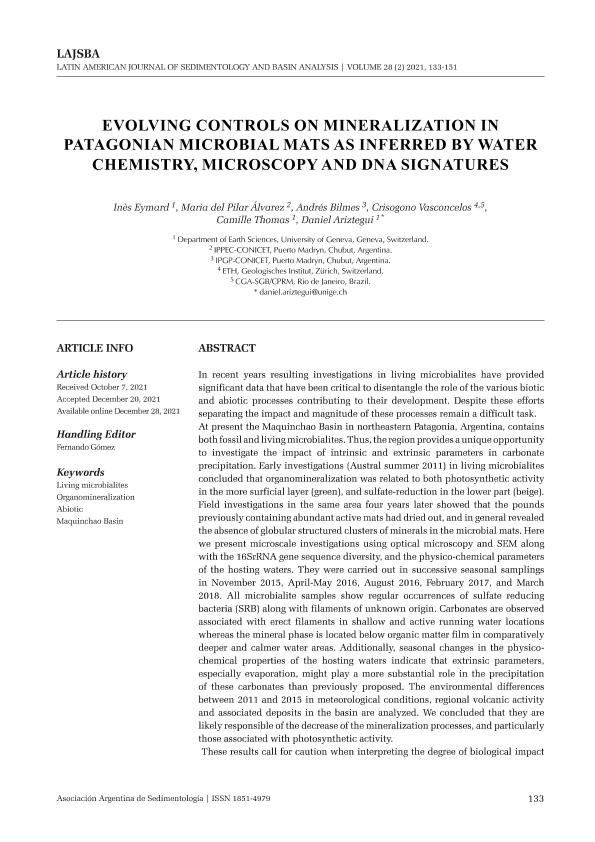Mostrar el registro sencillo del ítem
dc.contributor.author
Eymard, Inès
dc.contributor.author
Alvarez, Maria del Pilar

dc.contributor.author
Bilmes, Andrés

dc.contributor.author
Vasconcelos, Crisogono
dc.contributor.author
Thomas, Camille
dc.contributor.author
Ariztegui, Daniel
dc.date.available
2022-05-14T01:27:07Z
dc.date.issued
2021-12
dc.identifier.citation
Eymard, Inès; Alvarez, Maria del Pilar; Bilmes, Andrés; Vasconcelos, Crisogono; Thomas, Camille; et al.; Evolving controls on mineralization in patagonian microbial mats and DNA sigantures; Asociación Argentina de Sedimentología; Latin american journal of sedimentology and basin analysis; 28; 2; 12-2021; 133-151
dc.identifier.issn
1669-7316
dc.identifier.uri
http://hdl.handle.net/11336/157559
dc.description.abstract
In recent years resulting investigations in living microbialites have provided significant data that have been critical to disentangle the role of the various biotic and abiotic processes contributing to their development. Despite these efforts separating the impact and magnitude of these processes remain a difficult task.At present the Maquinchao Basin in northeastern Patagonia, Argentina, contains both fossil and living microbialites. Thus, the region provides a unique opportunity to investigate the impact of intrinsic and extrinsic parameters in carbonate precipitation. Early investigations (Austral summer 2011) in living microbialites concluded that organomineralization was related to both photosynthetic activity in the more surficial layer (green), and sulfate-reduction in the lower part (beige). Field investigations in the same area four years later showed that the pounds previously containing abundant active mats had dried out, and in general revealed the absence of globular structured clusters of minerals in the microbial mats. Here we present microscale investigations using optical microscopy and SEM along with the 16SrRNA gene sequence diversity, and the physico-chemical parameters of the hosting waters. They were carried out in successive seasonal samplings in November 2015, April-May 2016, August 2016, February 2017, and March 2018. All microbialite samples show regular occurrences of sulfate reducing bacteria (SRB) along with filaments of unknown origin. Carbonates are observed associated with erect filaments in shallow and active running water locations whereas the mineral phase is located below organic matter film in comparatively deeper and calmer water areas. Additionally, seasonal changes in the physico-chemical properties of the hosting waters indicate that extrinsic parameters, especially evaporation, might play a more substantial role in the precipitation of these carbonates than previously proposed. The environmental differences between 2011 and 2015 in meteorological conditions, regional volcanic activity and associated deposits in the basin are analyzed. We concluded that they are likely responsible of the decrease of the mineralization processes, and particularly those associated with photosynthetic activity. These results call for caution when interpreting the degree of biological impact on the formation of microbialites in the geological record. Local extrinsic factors might have a changeable impact over time switching mineral precipitation from biotic to abiotic and vice-versa, which can be undistinguishable in fossilized microbialites.
dc.format
application/pdf
dc.language.iso
eng
dc.publisher
Asociación Argentina de Sedimentología
dc.rights
info:eu-repo/semantics/openAccess
dc.rights.uri
https://creativecommons.org/licenses/by-nc-sa/2.5/ar/
dc.subject
LIVING MICROBIALITES
dc.subject
ORGANOMINERALIZATION
dc.subject
ABIOTIC
dc.subject
MAQUINCHAO BASIN
dc.subject.classification
Geociencias multidisciplinaria

dc.subject.classification
Ciencias de la Tierra y relacionadas con el Medio Ambiente

dc.subject.classification
CIENCIAS NATURALES Y EXACTAS

dc.title
Evolving controls on mineralization in patagonian microbial mats and DNA sigantures
dc.type
info:eu-repo/semantics/article
dc.type
info:ar-repo/semantics/artículo
dc.type
info:eu-repo/semantics/publishedVersion
dc.date.updated
2022-05-12T07:16:49Z
dc.identifier.eissn
1851-4979
dc.journal.volume
28
dc.journal.number
2
dc.journal.pagination
133-151
dc.journal.pais
Argentina

dc.journal.ciudad
La Plata
dc.description.fil
Fil: Eymard, Inès. Universidad de Ginebra. Facultad de Ciencias. Sección de Ciencias de la Tierra; Suiza
dc.description.fil
Fil: Alvarez, Maria del Pilar. Consejo Nacional de Investigaciones Científicas y Técnicas. Centro Científico Tecnológico Conicet - Centro Nacional Patagónico. Instituto Patagónico para el Estudio de los Ecosistemas Continentales; Argentina
dc.description.fil
Fil: Bilmes, Andrés. Consejo Nacional de Investigaciones Científicas y Técnicas. Centro Científico Tecnológico Conicet - Centro Nacional Patagónico. Instituto Patagónico de Geología y Paleontología; Argentina
dc.description.fil
Fil: Vasconcelos, Crisogono. Universitat Zurich; Suiza
dc.description.fil
Fil: Thomas, Camille. Universidad de Ginebra. Facultad de Ciencias. Sección de Ciencias de la Tierra; Suiza
dc.description.fil
Fil: Ariztegui, Daniel. Universidad de Ginebra. Facultad de Ciencias. Sección de Ciencias de la Tierra; Suiza
dc.journal.title
Latin american journal of sedimentology and basin analysis
dc.relation.alternativeid
info:eu-repo/semantics/altIdentifier/url/https://lajsba.sedimentologia.org.ar/index.php/lajsba/article/view/28-2-4
Archivos asociados
